Design of An Ergonomic Bass Guitar
Not long ago I was contacted by musician Santiago Arteaga who has been working for several years on “the design of an ergonomically enhanced bass guitar” – a project that began as his degree thesis in industrial design at the Universidad Nacional in Bogota, Colombia. Now having lived six years in Barcelona, Spain as a musician, Santiago has completed a new prototype five string fretless bass.
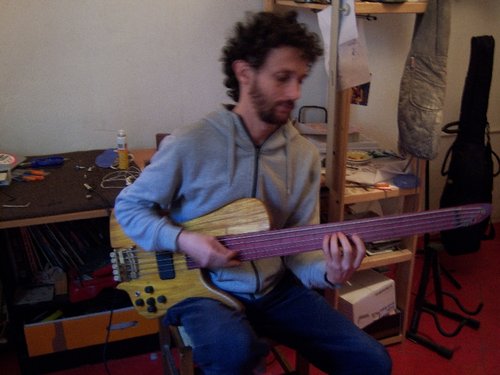
Researching Bass Design
Having convinced his instructors that his idea was a valid thesis project, Santiago struck out not to “revolutionize any concepts about musical instruments” but “rather try to implement enhancements on an already existing product.”
The first step was an analysis of the electric bass guitar over the last half century. Much of his research was done over the internet which helped to offset the difficulties of obtaining instruments to examine.
The second step was even more involved and Santiago describes it here…
After that followed anthropometric measurement, in order to justify many of the dimensions of many parts of the instrument, such as string spacing, body size, or nut width; for which a measurement of about 50 people of different ages and both sexes was made of sizes such as finger width, finger length, palm size, arm length, etc…
With measurements behind him, Santiago proceeded to interview bass guitarists…
A series of interviews were made with many bass players from the area, asking them about their playing-related illnesses, their choice of basses, and their opinion about these basses in a series of categories that were selected for them, as well as photographic and video recordings of every one.
Now it was time to pull the research together…
After this was done I had a list of conclusions and possible interventions that could be applied on the project, as well as a set of features that i liked as contributions by makers such as Steinberger, Klein (of course!), and more that i wanted to incorporate. In general the idea was to make the instrument adapt to the player rather than having the player adapt to the instrument (that was something that struck me as i stumbled upon your web site, to find such resonance in the community that you are creating!)
Building the Bass
Fast forward to several months ago when Santiago returned to Colombia for a 1 month trip and began work on prototype bass #2 – the result of working with Bogota luthier Andres Barrera who made the neck according to Santiago’s plans while Santiago focused on the bass body. A metal working shop built the bridge and tuners from Santiago’s plans.
Upon returning to Barcelona, the bass was assembled and completed within a month. This was back in November so the instrument has been played for three months now.
So what about prototype #1? Unfortunately, it was stolen after having been played for about 2 years. Santiago then focused on playing his G & L bass which also ended up stolen! Fortunately, this inspired him to return to his research and build #2.
Now let’s take a closer look…
The Bass Guitar
Starting at the top, the electric bass is not quite a headless guitar with its stub headstock. The design was chosen for “acoustical purposes, as the head mass provides resonance and sustain.”
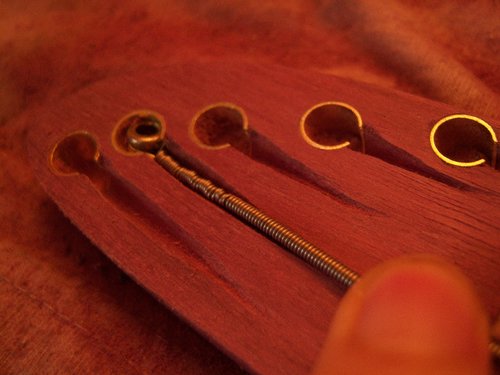
Although hard to make out in the very first image, the full access neck is mounted with a 10 degree downward rotation – a feature that reduces wrist flexion in the fretting hand. We’ve seen the concern over excessive wrist flexion addressed by luthier Jerome Little. A great example is Xavier Padilla’s Torzal Neck Bass Guitar. But unlike the complexity of twisting a neck throughout its length, Santiago’s solution is exciting for the ease with which an amateur builder can experiment with it in a design of his or her own.
According to Santiago, “the first prototype had a long horn, in order to provide balance and to bring the nut closer to the body, but in the next, the idea was to ‘close the gap’ and use the length of the body to embrace the neck and provide additional sustain and stiffness to the neck joint.”
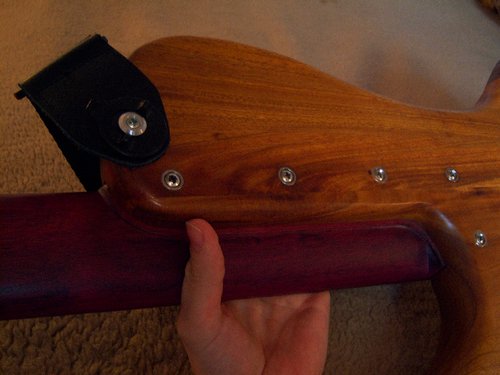
Santiago also designed his own tuning solution – a solid brass five string bridge and tuners system.
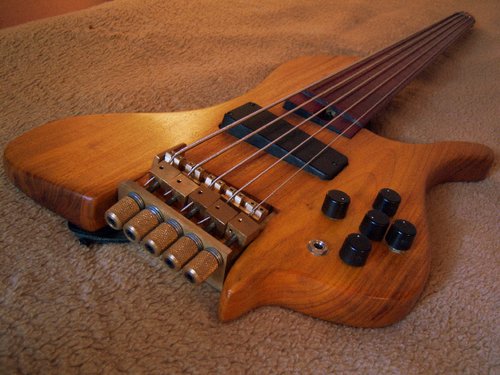
Here’s a closer look:
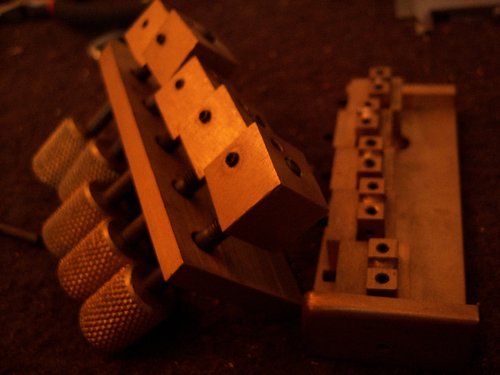
Woods include canarywood for the body and purpleheart for the neck.
Ergonomic Features
Some of its design elements include:
- A 10 degree downward rotation of the neck to reduce wrist flexion of the fretting hand
- “An exaggerated right arm rest to prevent it from bending the wrist”
- A body design that hugs the leg while seated providing greater stability
- Clear access to the entire neck (equivalent to 24 frets)
Observations
After playing it for the last several months, Santiago had these observations to share:
So far, in general, I like it a lot. I find that with this bass I can play things that I couldn’t play on the G & L especially in the upper register. I also find that I get less tired from carrying the bass around and doing long rehearsals and gigs. Standing up, it balances great but sitting down it’s a bit body heavy due to the massive bass bridge. Though I like the sustain that the brass bridge provides, a lighter aluminum prototype will be in the works or perhaps another model with reduced mass.
With such an interesting second bass guitar behind him, I suspect we’ll be seeing more of Santiago Arteaga’s ideas take shape in future instruments builds. Bien hecho, Santiago!
Many thanks to musician Santiago Arteaga for sharing his vision with Building the Ergonomic Guitar.
Looks very interesting and from your article here I would sure like to try it, even I can’t play fretless instruments.
thanks. i´m finishing right now a fretted version. It would be nice if you tried it, since i´m in spain, Romania sin´t that far away!!! 🙂
“Clear access to all 24 frets”
But it’s fretless!
Late night editing error! 🙂 What I meant to say was that it was equivalent to a 24 fret neck or a two octave range. Thanks for the catch!
What a beautiful instrument!
I thought so as well. Again, I have to thank Santi for sharing his build with us.
Very intriguing build!
When he’s playing – from the picture at least – he seems to have his picking/plucking hand above the fretboard (I know, I know it’s fretless!) all of the time. I would like to have the sound from picking near or close to the pickup. I wonder how much you have to retract your elbow and arm and if it can rest still, on the body.
I think I do want a more curve on the body, the back could be arched more to the human torso, just as the Klein KX-bass. Which reminds me of one thing, I should’ve presented that one as well, around here, ages ago.
Funny “headstock” solution though. Especially string guides. Headstock does have impact on sound, sustain as well as balance. Well done and well thought out!
hi mats
Many bass players vary the picking hand position depending on the sound that you need to get out of the instrument, closer to the bridge when you need more attack and precision, and closer (or even above) to the neck when you want the notes to “open” more (specially on the fretless),
I vary the arm position from one like the one in the first picture (for a warmer sound) to a position very close to the bridge, for which the shoulder muscle group lifts the arm. In this position the body still supports about half of my arm, still preventing the picking wrist from bending.
Right now i´m working on a more back arched bass, which is very useful, and is quite standard. I have never seen the klein KX bass. Do you have any pictures?
Thanks for the insightful comments
santi
Yes, I have promised to publish pictures of my Klein KX-bass replica around here for quite a while now. It seems one can’t do this without personally mailing the administrator. I will e-mail Robert now, with pictures.
Although you can see my pictures here:
http://launch.ph.groups.yahoo.com/group/kleinelectricguitars/photos/browse/535c
provided that you are a member of the Klein Electric group.
Mats – Message received! I’ll work on getting an article together ASAP.
So you know, I’ve been giving a lot of thought to the challenges presented by the site’s current format in terms of interaction and posting of material.
There are a few ways to proceed here each presenting its own challenges but I’m hoping to expand our community’s ability to interact and exchange information.
Intriguing rendition of a fretless bass. Nice instrument!
Nice feature with the hole for the string offset from the center axis of the plungers (or whatever you call the moving parts that the strings attach to) of the tuners. It allows the plungers to be way shorter since the threaded rod can go all the way through it.
Santiago, if you read this: How long travel do the plungers have? I assume they’ll have to allow for a somewhat slack string as you can tighten it all that much when mounting it. (I consider a similar system and might save some experimentations having an approximate figure)
Also, is the research you conducted formulated somewhere? It could be interesting to read the considerations on ergonomics, antrhopometrics, vibration, etc.
Alex says:
“Nice feature with the hole for the string offset from the center axis of the plungers … It allows the plungers to be way shorter since the threaded rod can go all the way through it.”
Funny, I was thinking that the offset attachment looks like it introduces some odd torque on the blocks. I was trying to imagine them skinnier, so the string hole could still be centered along the line of pull, and taller, so the adjustment screw could go under the string hole.
Ray
Forgot to add:
The general rule of thumb for guitars is 1/2″ of string take-up.
Ray
Hi again Santiago.
Whatever you do, don’t let this bass get stolen, too! 🙂
It seems you’ve been very unfortunate getting both your G&L and first prototype bass stolen. Take more care, and guard it.
Hi alex
answer this post and i´ll send you some pictures of my first bridge prototype. perhaps you´ll find them interesting. I was trying to eliminate the torque that ray de gennaro mentions, but i ended up gonig with it. the “plungers” as you call them or “string retainers” as i do have about 15 mm of travel.
Ray and Santi,
Sorry about the delay…
Ray, I see your point regarding torque. Having the string hole below the screw would give vertical torque instead, but that might be easier to manage depending on the design of the grooves in which the plungers move.
Thanks, both of you, for the travel estimates (1/2″ is 12.5 mm, so you confirm one another).
Santi, yes please, I’d like to see the pictures. My email address is agoest at gmail dot com.
So, is the torque mentioned by Ray a problem after all?
/Alex
Nice job on that bass! Will We ever get to see a video like on Youtube of Your bass being played? Pics are nice, but hearing it would be better:)
You´re absolutely right Chris.
Sorry about the delay, I hadn´t checked in a while, but there IS a little video of me improvising on my fretless. Here´s the link:
http://www.youtube.com/watch?v=KaCiR2Rar8A
I have found something very interesting here. I must try it after reading this article.
Hola santiago!
espero no molestar al escribir en castellano 😀 soy un luthier aficionado venezolano, he estado leyendo tu articulo y he visto que compartimos la misma inquietud de crear bajos mas cómodos de tocar y de cargar, me alegra mucho saber que no soy el único que anda probando y diseñando cosas nuevas para mejorar y hacer evolucionar las herramientas con las que contamos los músicos 😀
felicitaciones por tu trabajo!
A mi no me molesta mi pana!
Muchas gracias por el comentario. Ya ves que aquà hay toda una comunidad de curiosos. Me encantarÃa conocer tu trabajo. Donde lo puedo ver?
hola!
tengo unas fotos publicadas en flickr.com/photos/bajoscolmenares, aunq tengo esa página un poco olvidada, si quieres ver unas más actuales, tengo un grupo en el facebook llamado “Bajos Colmenares”, ahi si bastantes hay fotos y videos 😀
demás esta decir que cualquier comentario esta más que bienvenido
saludos!